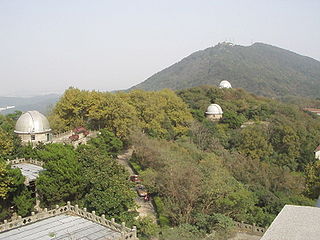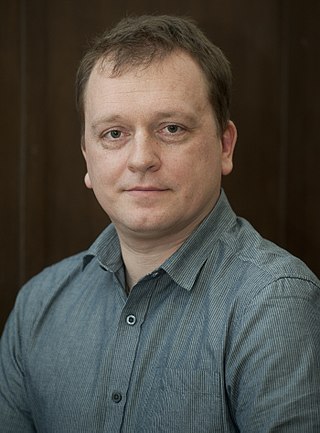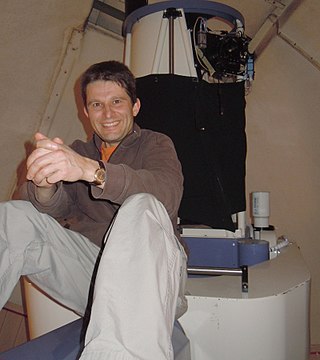Related Research Articles

Carolyn Jean Spellmann Shoemaker was an American astronomer and a co-discoverer of Comet Shoemaker–Levy 9. She discovered 32 comets and more than 500 asteroids.
In ancient times, only the Sun and Moon, a few stars, and the most easily visible planets had names. Over the last few hundred years, the number of identified astronomical objects has risen from hundreds to over a billion, and more are discovered every year. Astronomers need to be able to assign systematic designations to unambiguously identify all of these objects, and at the same time give names to the most interesting objects, and where relevant, features of those objects.

Johann Palisa was an Austrian astronomer, born in Troppau, Austrian Silesia, now Czech Republic. He was a prolific discoverer of asteroids, discovering 122 in all, from 136 Austria in 1874 to 1073 Gellivara in 1923. Some of his notable discoveries include 153 Hilda, 216 Kleopatra, 243 Ida, 253 Mathilde, 324 Bamberga, and the near-Earth asteroid 719 Albert. Palisa made his discoveries without the aid of photography, and he remains the most successful visual (non-photographic) asteroid discoverer of all time. He was awarded the Valz Prize from the French Academy of Sciences in 1906. The asteroid 914 Palisana, discovered by Max Wolf in 1919, and the lunar crater Palisa were named in his honour.

David Howard Levy is a Canadian amateur astronomer, science writer and discoverer of comets and minor planets, who co-discovered Comet Shoemaker–Levy 9 in 1993, which collided with the planet Jupiter in 1994.

The Purple Mountain Observatory, also known as Zijinshan Astronomical Observatory is an astronomical observatory located on the Purple Mountain in the east of Nanjing.
Roy A. Tucker (1951 – 2021) was an American astronomer best known for the co-discovery of near-Earth asteroid 99942 Apophis (formerly known as 2004 MN4) along with David J. Tholen and Fabrizio Bernardi of the University of Hawaii. He was a prolific discoverer of minor planets, credited by the Minor Planet Center with the discovery of 702 numbered minor planets between 1996 and 2010. He also discovered two comets: 328P/LONEOS–Tucker and C/2004 Q1, a Jupiter-family and near-parabolic comet, respectively.

Henry E. Holt was an American astronomer and prolific discoverer of minor planets and comets, who has worked as a planetary geologist at the United States Geological Survey and Northern Arizona University.
The Palomar Planet-Crossing Asteroid Survey (PCAS) was an astronomical survey, initiated by American astronomers Eleanor Helin and Eugene Shoemaker at the U.S Palomar Observatory, California, in 1973. The program is responsible for the discovery of 95 near-Earth Objects including 17 comets, while the Minor Planet Center directly credits PCAS with the discovery of 20 numbered minor planets during 1993–1994. PCAS ran for nearly 25 years until June 1995. It had an international extension, INAS, and was the immediate predecessor of the outstandingly successful NEAT program.
The Črni Vrh Observatory is an astronomical observatory located in western Slovenia, close to the settlement of Črni Vrh, near the town of Idrija. The current observatory was built in 1985 and stands at an elevation of 730 metres (2,400 ft). Much of the construction was done by volunteers.

Krisztián Sárneczky is a Hungarian teacher of geography and prolific discoverer of minor planets and supernovae, researching at Konkoly Observatory in Budapest, Hungary. He is a board member of the Hungarian Astronomical Association (HAA) and member of the American Association of Variable Star Observers, leader of the Comet Section of the HAA, and is a contributor in the editorial work of Hungarian Astronomical Almanach.
3673 Levy, provisional designation 1985 QS, is a binary Flora asteroid from the inner regions of the asteroid belt, approximately 6 kilometers in diameter. It was discovered on 22 August 1985, by American astronomer Edward Bowell at Lowell's Anderson Mesa Station near Flagstaff, Arizona, United States. The asteroid was named after Canadian astronomer David H. Levy.
1469 Linzia, provisional designation 1938 QD, is a dark asteroid from the outer regions of the asteroid belt, approximately 60 kilometers in diameter. Discovered by Karl Reinmuth at Heidelberg Observatory in 1938, the asteroid was later named after the Austrian city of Linz.
2074 Shoemaker, provisional designation 1974 UA, is a stony Hungaria asteroid, Mars-crosser and suspected synchronous binary system from the innermost regions of the asteroid belt, approximately 4 kilometers in diameter. It was discovered on 17 October 1974, by astronomer Eleanor Helin at the Palomar Observatory. She named it after American astronomer Eugene Shoemaker.
8373 Stephengould is an outer main-belt binary asteroid discovered on 1 January 1992 by Carolyn S. Shoemaker and Eugene Merle Shoemaker at Palomar Observatory. The asteroid was named after the Harvard paleontologist Stephen Jay Gould. The asteroid has a very high inclination, having the second highest inclination of any of the first 10,000 discovered asteroids in the asteroid belt, after 2938 Hopi.
Erwin Schwab is a German amateur astronomer and discoverer of minor planets, who works at the GSI Helmholtz Centre for Heavy Ion Research, near Darmstadt, Germany. He has discovered and co-discovered more than 80 asteroids from the Starkenburg, Tzec Maun and Taunus observatories. As volunteer scientist for the European Space Agency (ESA) he recovered near-Earth objects and comets. From 2014 to 2021 he recovered 30 lost comets, which equates to about 25% of the worldwide proportion in that timespan. Using the Schmidt telescope at Calar Alto Observatory to search for a lost comet he discovered in 2019 a unique variable star – the first known eclipsing stream-fed intermediate polar, cataloged as J1832.4-1627

Michel Ory is a Swiss amateur astronomer and a prolific discoverer of minor planets and comets.

Comets have been observed for over 2,000 years. During that time, several different systems have been used to assign names to each comet, and as a result many comets have more than one name.

Erwin Obermair was an Electrician, Austrian amateur astronomer and co-discoverer of asteroids.
Herbert Raab is an Austrian software engineer, amateur astronomer and discoverer of astronomical objects.
Tenagra Observatory and Tenagra Observatory II are astronomical observatories in Cottage Grove, Oregon and Arizona. The observatories house heavily automated robotic telescopes.
References
- ↑ "Minor Planet Discoverers (by number)". Minor Planet Center. 11 July 2018. Retrieved 17 July 2018.
- ↑ Minor Planet Discoverers - Minor Planet Center. Retrieved 2015-01-10.
- ↑ Minor Planet Discoveries - Webseite of the Davidschlag Observatory Archived 2015-01-10 at the Wayback Machine . Retrieved 2015-01-10.
- ↑ IAUC 5800: Periodic Comet Shoemaker-Levy 9 (1993e). Retrieved 2015-01-10.
- ↑ "Keplers Wohnadresse in Linz entdeckt - science.ORF.at". science.ORF.at (in German). 2018-05-08. Retrieved 2018-05-12.
- ↑ www.bilfinger.com https://web.archive.org/web/20150923185423/http://www.bilfinger.com/karriere/people-at-bilfinger/erich-meyer/. Archived from the original on 2015-09-23. Retrieved 2015-07-20.
{{cite web}}: Missing or empty|title=(help)[ title missing ] - ↑ Recipients of Medals of Honour for Services to the Republic of Austria (German). Retrieved 2015-01-10.
- ↑ Lutz D. Schmadel: Dictionary of Minor Planet Names (5th Edition), p. 624. Springer Verlag, Berlin/Heidelberg 2003, ISBN 3-540-00238-3
- ↑ The 2005 Gene Shoemaker NEO Grant Recipients. Retrieved 2015-06-26.